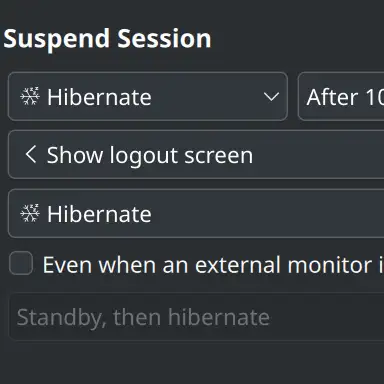Enable hibernation in CachyOS alongside zram swap with full disk encryption on BTRFS
How to enable hibernation in CachyOS alongside zram swap with full disk encryption on BTRFS

I use CachyOS on my laptop at the moment. I like to use the hibernation option, especially suspend-then-hibernate, but it’s not easy to enable in CachyOS, because there is no swap partition or swapfile created by default, because it utilizes zram. I wanted to use hibernation without losing the advantages of zram, so I went for a large swapfile with low priority to enable hibernation alongside zram. I use the default filesystem of CachyOS - BTRFS and I use full disk encryption. Here’s how I did it. Do this at your own risk, I am not responsible for mistakes I made or you make.
Steps to enable hibernation
Create a subvolume for your swapfile
sudo btrfs subvolume create /swapCalculate the size of your swapfile
It’s your zram size + your RAM size. You can see the size of your zram with:
swapon --showMine was 30GB and my RAM size is 30GB, so my swapfile needs to be 60GB. That’s a lot of space, but for me not a problem.
Create the swapfile
sudo btrfs filesystem mkswapfile --size 60g --uuid clear /swap/swapfileFind the UUID of the (virtual) device where the swapfile resides, copy it for later use
sudo findmnt -no UUID -T /swap/swapfileYou will get something like 58239ee3-aa2b-32ef-b7b2-2f591ee2251b
Aquire swap file offset, copy it for later use
sudo btrfs inspect-internal map-swapfile -r /swap/swapfileYou will something like 52635
Add kernel parameters you acquired is step 4 and 5
Edit the file
/etc/sdboot-manage.confand add resume=UUID=step 4 and resume_offset=step 5 in LINUX_OPTIONS=. It will look something like this:LINUX_OPTIONS="zswap.enabled=0 resume=UUID=58239ee3-aa2b-32ef-b7b2-2f591ee2251b resume_offset=52635 nowatchdog splash"Regenerate all systemd-boot entries with the following command
sudo sdboot-manage genConfigure initramfs - add resume hook
Edit the file
/etc/mkinitcpio.confand add resume into HOOKS= It must be after udev and encrypt. It will look something like this:HOOKS=(base udev autodetect microcode kms modconf block keyboard keymap consolefont plymouth encrypt resume filesystems)Regenerate initramfs
sudo mkinitcpio -PAdd swapfile to fstab with low priority
Edit the file
/etc/fstaband add on the last line:/swap/swapfile none swap defaults,pri=0 0 0Enable swap on running system
sudo swapon /swap/swapfileCheck if swap is enabled
swapon --showYou should now see something like
NAME TYPE SIZE USED PRIO
/swap/swapfile file 60G 0B 0
/dev/zram0 partition 30,7G 6,3M 100Reboot your system
After reboot, hibernation should be enabled in the settings of your Desktop Environment (if you use one). You can also test it on the command line with:
sudo systemctl hibernate
Suspend then hibernate
If you’re a fan of suspend-then-hibernate, like me (ideal for laptops if you ask me), you should edit the file /etc/systemd/sleep.conf, remove the # in front of HibernateDelaySec= and add the number of seconds. I have 7200 seconds (2 hours). You also need to configure it in your Desktop Environment after that. Gnome has no setting for that, but KDE Plasma (Settings-Power Managment) does.
/etc/systemd/sleep.conf
[Sleep]
#AllowSuspend=yes
#AllowHibernation=yes
#AllowSuspendThenHibernate=yes
#AllowHybridSleep=yes
#SuspendState=mem standby freeze
#HibernateMode=platform shutdown
#MemorySleepMode=
HibernateDelaySec=7200
#HibernateOnACPower=yes
#SuspendEstimationSec=60min
Sources used:
Boot Manager Configuration in CachyOS

